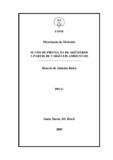| dc.creator | Dutra, Denecir de Almeida | |
| dc.date.accessioned | 2007-04-26 | |
| dc.date.available | 2007-04-26 | |
| dc.date.issued | 2005-05-10 | |
| dc.identifier.citation | DUTRA, Denecir de Almeida. AQUIFERS PROTECTION PLAN THE FROM AMBIENT VARIABLES. 2005. 113 f. Dissertação (Mestrado em Geociências) - Universidade Federal de Santa Maria, Santa Maria, 2005. | por |
| dc.identifier.uri | http://repositorio.ufsm.br/handle/1/9587 | |
| dc.description.abstract | The available water reserve, economically viable for the human consumption, only restricts that parcel that if finds in the superficial and groundwater form, that represents only 0.7% of the water fresh existing in the surface of the Land. Like this, the present study it had as objective generality to propose a plan of protection of aquifers for the watershed of the Arroio Ferreira, located in the city of Santa Maria/RS. The specific objectives were to identify the from partner-ambient variables of the watershed, to elaborate plain of information with the use of the technology GIS and to establish the crossing of the information plans, being gotten itself thus zones of aquifers protection. In this way, defined five zones of protection of the aquifers: Zone I - Immediate protection, Zone II - Restriction and control, Zone III - Without restriction, Zone IV - Prevention and Zone V - Direct influence of watercourse, adapted of the norms established for the protection of the wells and areas of aquifers recharge, as well as of previous works. As we could observe the watershed of the Arroio Ferreira presents propitious natural conditions to the contamination of groundwaters, beyond to belong hydrogeology of the Aquifer System Guarani. The generated plans of information with the use of the technology GIS, had assisted for the definitions of the zones of protection of the aquifers. Conclude, therefore that, the preservation of the amount and the quality of the groundwater, as much for this as for the future generations, not only depends on the actions of the professionals of the area, but also of each individual of the society, respecting the restrictions and conditions proposals to the implantation or development of socioeconomic as activities, as well as of the measures of control of the sources of pollution in each zone of protection. | eng |
| dc.format | application/pdf | por |
| dc.language | por | por |
| dc.publisher | Universidade Federal de Santa Maria | por |
| dc.rights | Acesso Aberto | por |
| dc.subject | Hidrologia | por |
| dc.subject | Água subterrânea | por |
| dc.subject | Aqüíferos | por |
| dc.subject | Recursos hídricos | por |
| dc.subject | Geoprocessamento | por |
| dc.subject | Arroio Ferreira | por |
| dc.title | Plano de proteção de aqüíferos a partir de variáveis ambientais | por |
| dc.title.alternative | Aquifers protection plan the from ambient variables | eng |
| dc.type | Dissertação | por |
| dc.description.resumo | A reserva de água disponível, economicamente viável para o consumo humano, restringe-se somente aquela parcela que se encontra na forma de água superficial e subterrânea, que representa apenas 0,7% da água doce existente na superfície da Terra. Deste modo, o presente estudo teve como objetivo geral propor um plano de proteção dos aqüíferos para a microbacia hidrográfica do Arroio Ferreira, localizado no município de Santa Maria/RS. Sendo os objetivos específicos identificar as variáveis sócio-ambientais da microbacia, elaborar planos de informação com o uso das técnicas de SIG e estabelecer o cruzamento dos planos de informação, obtendo-se assim zonas de proteção dos aqüíferos. Desta forma, definiu-se cinco zonas de proteção dos aqüíferos: Zona I - Proteção imediata, Zona II - Restrição e controle, Zona III - Sem restrição, Zona IV Prevenção e Zona V Influência direta de cursos d água, adaptadas das normas estabelecidas para a proteção dos poços e áreas de recarga aqüífera, bem como de trabalhos anteriores. Como pudemos observar a microbacia do Arroio Ferreira apresenta condições naturais propícias à contaminação das águas subterrâneas, além de fazer parte hidrogeológicamente do Sistema Aqüífero Guarani. Os planos de informação gerados com o uso das técnicas de geoprocessamento, auxiliaram para as definições das zonas de proteção dos aqüíferos. Conclui-se, portanto que, a preservação da quantidade e da qualidade da água subterrânea, tanto para esta como para as futuras gerações, depende não somente das ações dos profissionais da área, mas também de cada indivíduo da sociedade, respeitando as restrições e condições propostas à implantação ou desenvolvimento de atividades socioeconômicas, bem como das medidas de controle das fontes de poluição em cada zona de proteção. | por |
| dc.contributor.advisor1 | Cassol, Roberto | |
| dc.contributor.advisor1Lattes | http://buscatextual.cnpq.br/buscatextual/visualizacv.do?id=K4787538A5 | por |
| dc.contributor.referee1 | Madruga, Pedro Roberto de Azambuja | |
| dc.contributor.referee1Lattes | http://buscatextual.cnpq.br/buscatextual/visualizacv.do?id=K4789444P1 | por |
| dc.creator.Lattes | http://buscatextual.cnpq.br/buscatextual/visualizacv.do?id=K4778131Z1 | por |
| dc.publisher.country | BR | por |
| dc.publisher.department | Geociências | por |
| dc.publisher.initials | UFSM | por |
| dc.publisher.program | Programa de Pós-Graduação em Geomática | por |
| dc.subject.cnpq | CNPQ::CIENCIAS EXATAS E DA TERRA::GEOCIENCIAS | por |


